Before arthroscopy, the patient is examined by a traumatologist, a general practitioner and an anesthesiologist. In addition, a standard examination before the operation is required. This includes blood tests: general blood count, biochemistry, blood clotting, tests for syphilis, HIV and hepatitis. Also, an ECG is performed with the description of a cardiologist. If you have had previous treatments or diagnostic procedures on the shoulder, it is advisable to bring the relevant medical records with you to the examination.
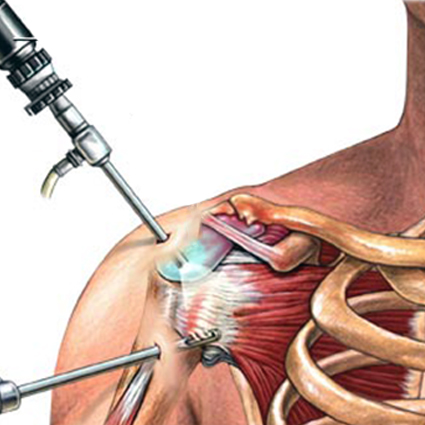
- shoulder endoprosthesis
- Indications and contraindications
- Surgery on the shoulder
- Why is shoulder treatment better with us?
- Day of surgery:
- Our reviews
- Consultation of an orthopedic traumatologist
- recovery and rehabilitation
- Shoulder endoprosthesis
- types of prostheses
- Types of endoprostheses and prices
- Arthroscopic surgery for impingement syndrome
- Arthroscopic surgery for SLAP injury
- Symptoms:
- How the operation is performed
- Cost of shoulder surgery in Moscow
- Indications and contraindications
- recovery and rehabilitation
- Cost of shoulder arthroscopy
shoulder endoprosthesis
The shoulder is the most mobile joint in the world. Injuries or fractures of the shoulder joint lead to discomfort and severe pain, which can occur both during movement and at rest. This affects daily life and causes great discomfort.
The solution to this problem is replacement of the shoulder joint, known as shoulder arthroplasty. This is a surgical procedure in which the patient is fitted with an artificial prosthesis. The operation is performed when the shoulder joint cannot be restored using other methods.
The specialists in our rehabilitation center have extensive experience in endoprosthetics. Ask us and we will help you!
Shoulder arthroplasty guarantees a fulfilling and active life. Free from pain and discomfort.
Indications and contraindications
- fractures of the proximal side of the humerus;
- post-traumatic osteoarthritis;
- osteonecrosis of the bone head; congenital articular dysplasia;
- degenerative-dystrophic symptoms as a result of tears in the rotator cuff of the shoulder;
- rheumatoid arthritis or other connective tissue diseases.
- severe osteoporosis;
- bone necrosis;
- purulent inflammatory pathologies of organs and systems;
- bacterial infections;
- psychiatric disorders;
- neurological paralysis;
- recent stroke or myocardial infarction;
- are over 75 years old.
Surgery on the shoulder
Minimally invasive surgeries are performed through small, 5mm incisions in the tissue into which surgical instruments and an optical device called an arthroscope are inserted.
The procedure causes minimal tissue damage, reducing pain and hospitalization (up to 1-2 days); further advantages are a short rehabilitation time and fewer postoperative complications.
Postoperative rehabilitation techniques include: anesthesia, decongestion, applying an immobilizing bandage immediately after the manipulation, massage, physiotherapy, therapeutic exercises – exercises to stimulate blood circulation and strengthen muscle tone.
Why is shoulder treatment better with us?
Our specialist clinic for traumatology and sports orthopedics offers patients surgical treatment and rehabilitation for all types of shoulder injuries. We deal with all problems of the shoulder joint: humerus, scapula and shoulder articular processes. When the patient comes to us, he gets a solution to his problem. Clinical examinations and precise diagnostics allow us to determine the necessary treatment. Individual treatment of each patient is the guarantee of maximum treatment effect.
The clinic is equipped with modern diagnostic, surgical and physiotherapeutic equipment from Linvatec, General Electric and Drager. In preparation for a surgical procedure, patients can undergo a full examination, including X-ray, MRI, CT, ultrasound and laboratory tests.
There is an inpatient department with spacious single and double rooms equipped with everything you need for a comfortable stay. During treatment, patients are provided with a five-course diet. The rehabilitation rooms are equipped with modern physiotherapy equipment and simulators for therapeutic physical training.
Our patients include famous footballers, ice hockey players, track and field athletes, figure skaters, and skiers who, thanks to the treatment, have been able to return to the sport and set new records.
The costs for a shoulder arthroscopy can be found under COST OF TREATMENT.
Make an appointment now – early treatment guarantees the best possible result!
If you've suffered a shoulder dislocation, if you're plagued by pain, limited movement, unsteadiness, or stiffness, surgery or shoulder dislocation treatment may help.
Day of surgery:
In the morning, after personal hygiene, the patient is sedated to level the emotional background and minimize fear of the operation.
After the operation, the patient is transferred to the ward under the supervision of the nursing staff. In the postoperative phase, the hand is immobilized with an orthosis for 4 to 6 weeks. After that, rehabilitation treatment tailored to the needs of the patient begins.
For optimal rehabilitation after an artificial joint replacement, you should already carry out the first static exercises 1-2 days after the operation. Rehabilitation physiotherapy begins with simple exercises on the healthy hand. Gradually, the exercises become more difficult, and after a month the patient is able to perform active exercises with the weight of the operated hand.
If the postoperative period goes smoothly, then after 2-3 days the patient is discharged from the hospital for outpatient treatment. Before discharge, the trauma surgeon will inform you about the treatment regime, the necessary medication and the frequency of radiological examinations and doctor's appointments. In order to speed up recovery and adjustment after the operation, the patient goes through a rehabilitation course, which includes drug therapy, physiotherapy treatments, and therapeutic physical exercises.
The high quality of the equipment and the professionalism of the doctors of the trauma department of the Center for Traumatology and Orthopedics of the NN Burdenko Hospital ensure quick and easy rehabilitation after the operation.
Learn more about shoulder arthroplasty from the hospital's specialists. We are ready and happy to help you.
The cooperation between the doctors of the Center for Traumatology and Orthopedics of New Medicine and Telemed opens up new possibilities for patients with diseases of the musculoskeletal system for high-quality rehabilitation with professional high-tech rehabilitation equipment.
Our reviews
I would like to express my sincere gratitude to the doctors of the Trauma Surgery Department III, Boris Vladimirovich Tyulkevich and Andrei Andreyevich Gritsyuk for the operation that restored her hand. She was admitted to Burdenko Hospital in January 2023. In January 2023, I was admitted to Burdenko Hospital with a hand injury - a fused fracture of the lower limbs of the radius and elbow. At first I was in shock - I went to work and ended up in the hospital. Now I understand that I was incredibly lucky to end up in Burdenko Hospital. The best doctors. The highest level of professionalism and human qualities, or what is called a 'real doctor'. I felt that the doctors were doing everything they could to achieve the best possible outcome. A big THANK YOU to all the doctors involved in the operation (unfortunately I don't know all their names). Incredibly clear and coordinated work from the entire team. The level of difficulty and the way the doctors work (one operation at a time) commands my sincere respect! I know from experience that a fracture is not only a physical pain, but also a mental disconnection from everyday life. I would like to thank Doctor Lenar for the well-chosen exercises and last but not least for the positive attitude that everything will be fine. I thank all the medical staff for their kind attitude and help, which is especially important after the operation when you cannot do the simplest things yourself. Happy Father's Day! I wholeheartedly wish you health, prosperity and strength for your hard and noble work. You are the BEST because you are REAL! With respect and gratitude, Svetlana Grishkova PS I wrote this report myself, a month after the operation :)
The history of military medicine began with the establishment of the hospital named after NN Burdenko. NN Burdenko, which is still in operation today. It owes this to the top-class medical staff of the hospital. One of these top-class doctors is Yuriy Viktorovich Arbuzov, who has the most advanced method of surgical treatment of the Achilles tendon. Yuri is the owner of the only patent in Russian and European medicine for an invention that allows the damaged Achilles tendon to be reconstructed in an unconventional way. I experienced this method of treating a chronic Achilles tendon rupture myself when Dr. Arbuzov, thanks to his skills, his experience as a surgeon and his high human qualities, with care and attention, performed a surgical intervention on me that resulted in the restoration of motor function of the leg. I speak dr Arbuzov Yuri Viktorovich expresses my heartfelt gratitude and sincere appreciation and, on behalf of grateful patients, wish him new successes! Retired Colonel Pavel Kulikov, veteran of the Russian Armed Forces.
Consultation of an orthopedic traumatologist
The traditional method is open surgery with an incision of a few centimeters. The more modern method that we use in our center is arthroscopic access (for minor injuries) or mini open access with anchoring (for major injuries). The procedure is called arthroscopic suturing of the rotators (rotator cuff) of the shoulder.
Arthroscopy is a minimally invasive technique that offers the patient minimal risk, good tolerability, and a speedy recovery. The trauma surgeon performs all the necessary manipulations through small punctures using a microscopic video camera.
Once the torn area is visible, the doctor sutures the damaged rotator cuff tendon fragments to their anatomical attachment zone using special anchor fixators (1 to 3, depending on the extent of the injury).
Arthroscopic procedures to restore rotator cuff integrity are among the most challenging tasks in arthroscopic surgery.
The coordinated work of the team of the Center for Traumatology and Orthopedics V. Lomtatidze and the full technical equipment of the clinic allow us to perform arthroscopic sutures of the rotator cuff at the highest world level.
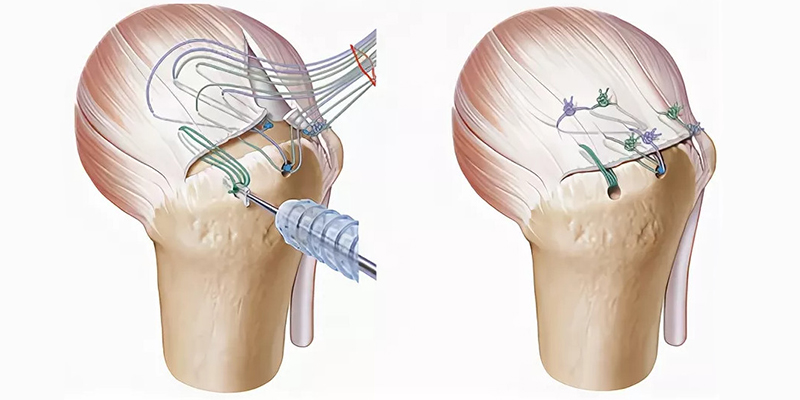
recovery and rehabilitation
Length of hospital stay 1 day. After arthroscopic suturing of the rotator cuff, the shoulder is immobilized (fixed) in a retracted position for 3-6 weeks. This avoids the risk of the tendon tearing again during the healing phase.
Once the brace is removed, you should exercise the joints and strictly follow the recovery protocol prescribed by the surgeon.
Return to full life 2-3 months after surgery. In the first 6 months, however, you should not put more than 2.5 kg on your shoulder.
Shoulder endoprosthesis
Modern medicine has a wide range of devices for treating various types of shoulder joint injuries. However, sometimes a full or partial replacement is required.
- osteonecrosis - cell death in the head of the bone;
- Multiple compound fractures and fractures of the head;
- Poorly healed old fractures with no possibility of restoring normal joint anatomy;
- Arthrosis;
- irreversible pathologies of the rotator cuff;
- neoplastic diseases.
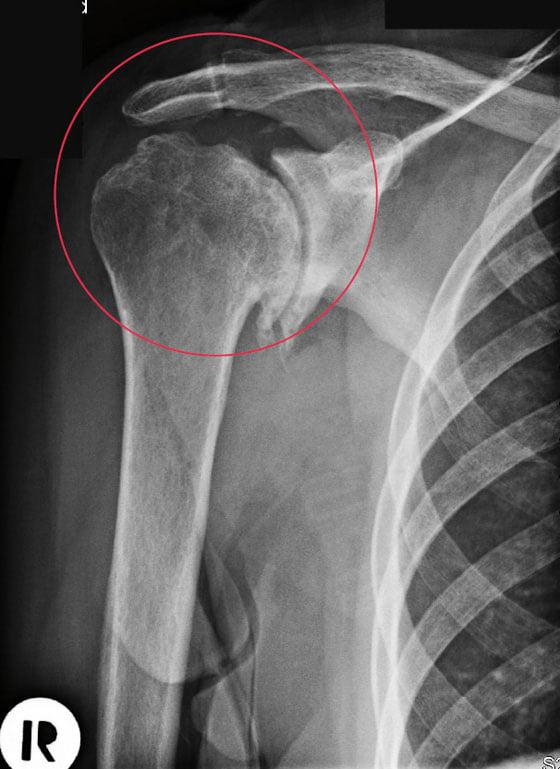
types of prostheses
Depending on the extent of the injury, the following types of shoulder prostheses are distinguished:
- superficial. It is used when the patient's bone head is only slightly damaged and much bone tissue can be preserved. The head of the bone is removed with a special instrument and an implant is placed to replace the articular surface.
- unipolar. The implant is placed either in the shoulder or in the head of the bone.
- Complete. In this procedure, all associated parts are replaced: both the head and the acetabulum. Two different techniques are possible: only the joint components have to be implanted, or a rod prosthesis can be implanted and fixed in the bone cavity.
- revision. It is performed when a worn implant or sub-components of the implant need to be replaced. Revision surgery is also performed for complications such as rejection, inflammation, and purulent conditions.
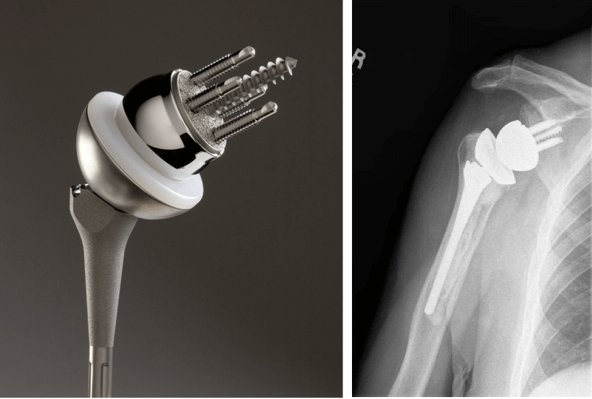
The price of a shoulder arthroplasty depends on the list of services provided by the clinic as part of the operation, the type of surgical intervention and the method of attachment of the prosthesis.
Types of endoprostheses and prices
Leg implants can be anatomical or reversible. An anatomical implant consists of three parts: the head, the stem and the acetabular cup. It is so named because it fully replicates the structure of the human shoulder, both in terms of biomechanics and shape.
Insertion of such a prosthesis is only possible if the rotator cuff is intact. Products from leading manufacturers such as DePuy, Zimmer, Smith & Nephew, Biomet, Aesculap – B. Braun are used for replacement.
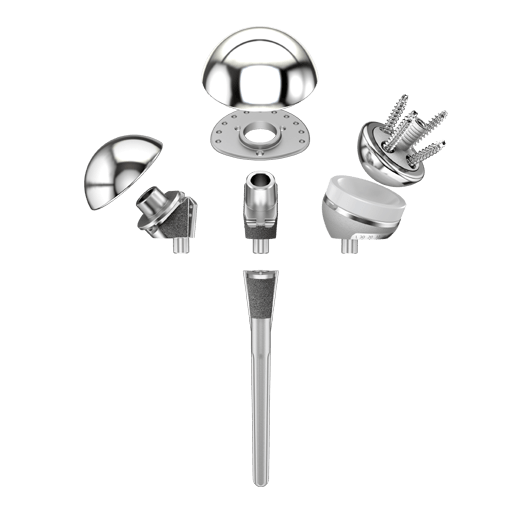
The reverse, or inverted, variation is used when the rotator cuff is dysfunctional and stability is compromised. The head is then attached to the socket (glenoid component), and a concave socket implant on a stem is fixed to the humerus.
Arthroscopic surgery for impingement syndrome
One of the most common reasons for shoulder surgery is to treat impingement syndrome. This is a condition in which the tendons of the rotator cuff are periodically compressed during movement. This leads to progressive damage to the tendons and bursa in the joint.
Arthroscopic shoulder surgery to correct impingement syndrome is called subacromial decompression. The aim of the surgery is to increase the distance between the rotator cuff and the top part of the scaphoid (called the acromion). Hence the second name of the operation is acromionoplasty.
In subacromial decompression, the surgeon removes the bursa or excess acromial tissue. This creates space for the rotator cuff to move freely without being pinched between the bones.
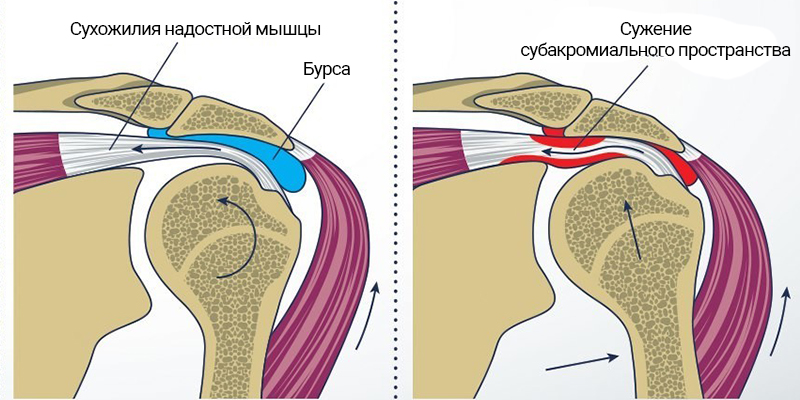
Arthroscopic surgery for SLAP injury
SLAP is an injury to a part of the shoulder joint called the labrum. Just like the hip joint, the shoulder joint consists of a ball joint and a socket part. However, unlike the hip joint, the acetabulum of the shoulder joint is very flat and therefore inherently unstable. This means that the shoulder is susceptible to dislocation and injury if the ball comes out of the socket.
To compensate for the flat hip socket, the shoulder joint has a cartilage called the labrum. It forms a socket for the humeral head. The shoulder labrum essentially deepens the hip socket of the shoulder joint. Damage to the synovial membrane requires surgical treatment.
The synovial membrane is restored to its normal position through an arthroscopic procedure. The cartilage is then sewn to the bone. If the damage extends to the biceps tendon, additional surgery may be needed.
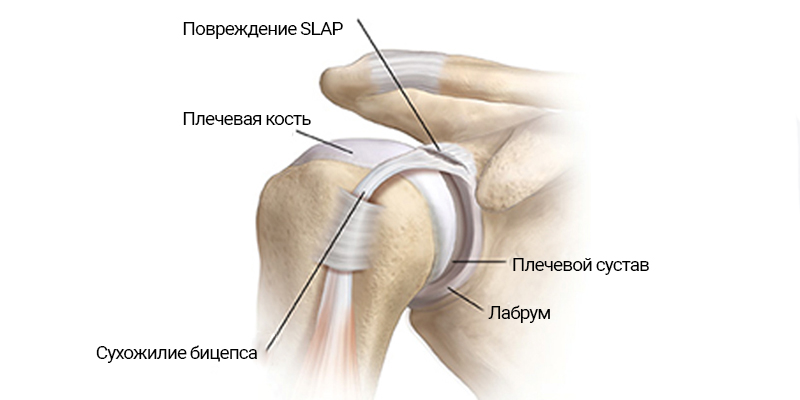
Symptoms:
- Acute pain on twisting movements
- Acute pain on stretching movements
- Foreign body sensation in the joint
- Discomfort and pain in the joint
- No effect of conservative treatment
- One of the leading specialists in the field of arthroscopic surgery, Vakhtang Lomtatidze, a recognized expert in the field of arthroscopic surgery in Russia, who received education and training in many countries around the world, works in our center
- minimal Minimal risk of complications.
- Affordable prices forarthroscopy. The price of the intervention starts from 73,000 rubles.
- exact Diagnosis (we identify your problem and solve it).

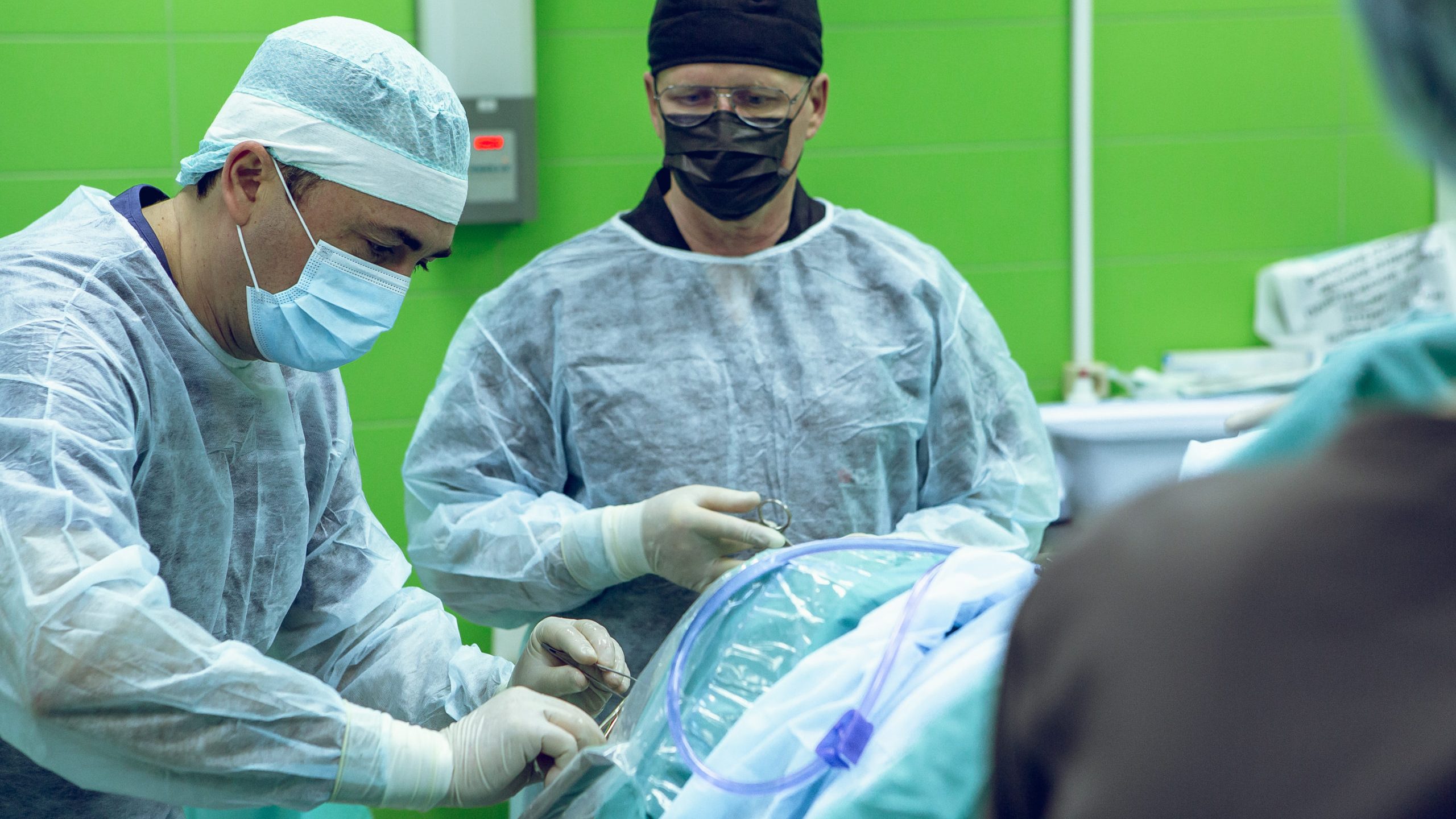
thanks to the Arthroscopic SurgeryAny joint in the body can be treated (or diagnosed) with arthroscopic surgery: knee, ankle, hip, shoulder, elbow, wrist, etc.
How the operation is performed
Arthroscopic surgery is a minimally invasive but highly effective closed procedure. Each operation follows a series of standard steps:
- Anesthesia. This is usually a local anaesthetic, in severe cases a general anaesthetic.
- The surgeon makes a small incision (about 5 mm). Some operations require 2-3 such micro-cuts.
- Through these incisions, the surgeon inserts an arthroscope and the necessary surgical tools into the joint cavity.
- The arthroscope is equipped with a video camera that transmits a magnified image to a large screen in the operating room. Sterile fluid is continuously injected into the joint cavity to increase volume. The orthopaedist/traumatologist looks at the screen and performs all surgical procedures.
- All instruments are then removed and the liquid is suctioned out. The incisions are sutured and a sterile bandage is applied.
Contraindications for arthroscopic surgery
- Ankylosis (poor mobility of the joint due to a closed defect)
- presence of inflammation (pus) in the joint area;
- open trauma of the joint with ligament injuries;
- acute hepatitis.
Arthroscopy takes 2-3 hours, depending on the type of anesthesia, and the patient is discharged the same day or the next morning.
The patient is quickly reactivated and is fully functional again within a week. On the 4th and 5th day, light exercises can be started to develop the joint. Flexion of the joint can be started after 6-7 days. The load should be applied gradually and carefully. Full recovery takes between 6 weeks and 4 months, depending on the type of procedure and the complexity of the condition.
The rehabilitation measures are taken by the surgeon on an individual basis.
Joint arthroscopy is a safe procedure. The complication rate is less than 1 percent and mainly affects infections of the joint cavity, healing incisions or problems waking up from anesthesia. These risks are no higher than with the simplest surgical interventions.
Cost of shoulder surgery in Moscow
Open surgery to stabilize a recurrent habitual shoulder dislocation - soft tissue revision procedures
Open surgery to stabilize recurrent habitual shoulder dislocation - revision - soft tissue
Open surgery to stabilize recurrent habitual shoulder dislocation - revision - soft tissue
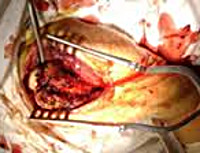
The shoulder surgery – is the surgical treatment of recurring dislocations of the shoulder joint, certain diseases and injuries of the shoulder joint. The aim is to restore or improve the function of the joint, to correct changes caused by illness and injury and to prevent the damage from progressing. The interventions are usually routinely performed under general anesthesia or instrumentally in the trauma ward, with the choice of approach depending on the nature of the pathology. In the postoperative period, corrective measures are carried out.
Indications and contraindications
Shoulder operations are performed for habitual dislocation of the shoulder joint, severe injuries to the humeral head (multiple contusions and fractures), deformative arthritis, purulent arthritis, and certain other diseases. The goal of the procedure depends on the type of injury and can generally be outlined as maximizing the functionality of the limb given the existing lesions. The list of general contraindications includes the general severity of the patient's condition, decompensated therapeutic pathology, acute infections, blood coagulation disorders. Local contraindications include inflammatory processes in the joint and soft tissue infections in the access area.
Based on the structures affected, all interventions in this group can be divided into three large categories:
- Operations on the surrounding soft tissues. Are usually performed in habitual shoulder dislocations. Performed to strengthen the shoulder joint and prevent re-dislocation. They may involve opening the joint cavity or they may be performed outside of the joint cavity.
- Bone interventions with opening of the joint cavity. This group of surgical techniques includes resection, intra-articular arthrodesis, arthroplasty, and bone surgery for habitual dislocation of the shoulder joint.
- Bone operations without opening the joint cavity. These operations are rarely performed. This includes extra-articular arthrodesis, in which a bone shaft is inserted outside of the shoulder joint.
recovery and rehabilitation
Depending on the type of manipulation performed, a fixation bandage may be required. Your wounds will be bandaged under medical supervision before the stitches are removed. During the recovery period you must:
- Cool the operated area;
- taking antibiotics prescribed by your doctor to prevent postoperative infection;
- if necessary, take painkillers;
- wear a special cut-off when removing the fixation bandage;
- From the first postoperative day until full recovery, carry out physical therapy;
- Limit your physical activity.
Cost of shoulder arthroscopy
The prices for a shoulder arthroscopy depend on the length of stay in the clinic, the comfort of the room, the prices of disposable materials, the drugs used, the inpatient costs and meals. For a definitive estimate and if you have any questions for the surgeon, make an appointment with us by calling the number on our website.
Head of the Department of Traumatology and Orthopedics 2, Federal State Budget Department, Federal Scientific and Research Center, Federal Medical and Biological Agency of Russia
Read more:- How much does shoulder dislocation surgery cost?.
- How much does knee surgery cost?.
- shoulder supinators.
- Pronation of the shoulders - what is it?.
- How much does a shoulder prosthesis cost?.
- tearing of the joint capsule.
- How much does meniscus surgery cost?.
- How much does a hip prosthesis cost?.
